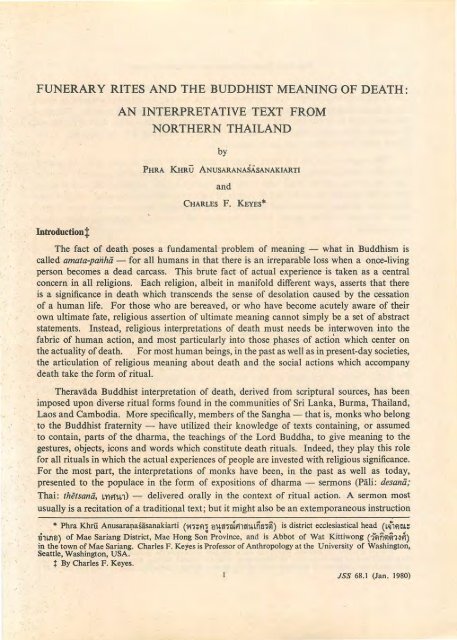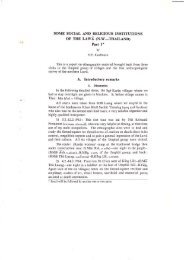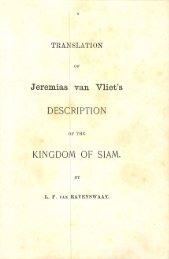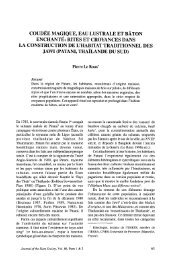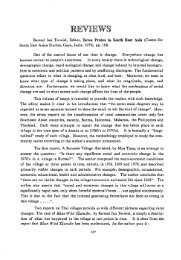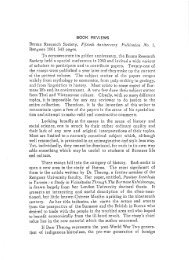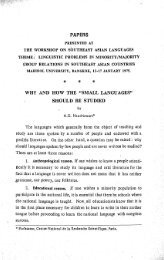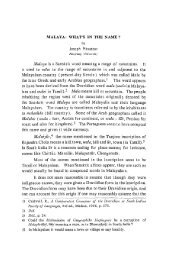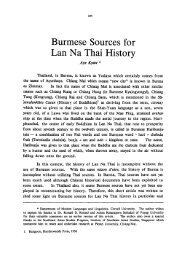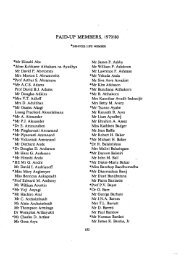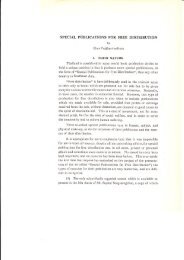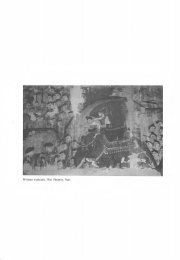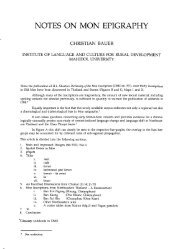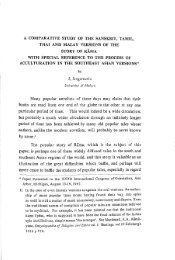funerary rites and the buddhist meaning of death - Siamese Heritage ...
funerary rites and the buddhist meaning of death - Siamese Heritage ...
funerary rites and the buddhist meaning of death - Siamese Heritage ...
You also want an ePaper? Increase the reach of your titles
YUMPU automatically turns print PDFs into web optimized ePapers that Google loves.
2 Phra Khru Anusaraf!asasanakiarti & Charles F. Keyes<br />
concerning <strong>the</strong> deeper dharmic <strong>meaning</strong>s <strong>of</strong> aspects <strong>of</strong> <strong>the</strong> human condition. Relatively<br />
rarely, although increasingly more common, a monk has put his religious exegesis <strong>of</strong> ritual<br />
into writing, <strong>the</strong>reby making it available for o<strong>the</strong>rs to read or to use as a sermon. Whatever<br />
<strong>the</strong> form might be, it has been <strong>the</strong> responsibility <strong>of</strong> monks from <strong>the</strong> earliest days <strong>of</strong> Buddhism<br />
to provide o<strong>the</strong>rs with religious - that is, dharmic - <strong>meaning</strong>s for <strong>the</strong> elements <strong>of</strong> <strong>the</strong><br />
rituals which punctuate <strong>the</strong> process <strong>of</strong> human life.<br />
This responsibility has led many monks to attend to <strong>the</strong> form as. well as to <strong>the</strong> content<br />
<strong>of</strong> rituals. Indeed, in any Buddhist community it is always <strong>the</strong> monk (or ex-monk) who has<br />
spent- many years in <strong>the</strong> Order who is <strong>the</strong> most knowledgeable regarding <strong>the</strong> traditional as<br />
well as <strong>the</strong> essential (as prescribed by scriptural authority) elements <strong>of</strong> ritual. Again, this<br />
knowledge has been communicated to o<strong>the</strong>rs mainly by word <strong>of</strong> mouth; however, a few monks<br />
have composed written guides to <strong>the</strong> procedure <strong>of</strong> <strong>the</strong> rituals performed within <strong>the</strong>ir<br />
communities.<br />
The text which I have translated here combines both an account <strong>of</strong> ritual procedure -<br />
in this case, <strong>of</strong> <strong>the</strong> forms <strong>of</strong> rituals connected with <strong>death</strong> as <strong>the</strong>y are carried out in <strong>the</strong> community<br />
<strong>of</strong> Mae Sariang in nor<strong>the</strong>rn Thail<strong>and</strong> - with a dharmic interpretation <strong>of</strong> this procedure.<br />
This text is unusual in that it was not composed for <strong>the</strong> benefit <strong>of</strong> practising Buddhists in<br />
Mae Sariang, but for <strong>the</strong> purpose <strong>of</strong> providing a foreign ethnographer - myself- with some<br />
depth <strong>of</strong> underst<strong>and</strong>ing <strong>of</strong> <strong>death</strong> rituals which I had observed while engaged in research in<br />
Mae Sariang.<br />
I spent nearly 18 months in Mae Sariang during 1967-1968, engaged in a study <strong>of</strong> <strong>the</strong><br />
religious life <strong>of</strong> nor<strong>the</strong>rn Thai Buddhists living in Mae Sariang town as well as o<strong>the</strong>r aspects<br />
<strong>of</strong> culture <strong>and</strong> society in Mae Sariang District. 1 I was extraordinarily fortunate in my work<br />
on Buddhist practice to gain not only <strong>the</strong> approval <strong>of</strong> Phra Khrii AnusaraQasasanakiarti,<br />
<strong>the</strong> district ecclesiastical head <strong>of</strong> Mae Sariang District, but also his active involvement in<br />
my undertaking. To this day he maintains an abiding interest in <strong>the</strong> culture <strong>of</strong> his native place,<br />
<strong>and</strong> pursues this interest with intellectual inquisitiveness. On many occasions, I discovered<br />
that my naive queries as to <strong>the</strong> nature <strong>of</strong> some practice served to stimulate him to provide<br />
me with a detailed <strong>and</strong> systematic account. Towards <strong>the</strong> end <strong>of</strong> my stay in Mae Sariang, he<br />
prepared, at my behest, a set <strong>of</strong> detailed notes on many <strong>of</strong> <strong>the</strong> ritual practices which I had<br />
observed. The record <strong>of</strong> customs associated with <strong>death</strong> which is presented here was originally<br />
written on 2 November 1968.<br />
In <strong>the</strong> intervening decade, I have not had <strong>the</strong> time to return to this text, being concerned<br />
with o<strong>the</strong>r work growing out <strong>of</strong> my research in Mae Sariang, as well as o<strong>the</strong>r research in<br />
nor<strong>the</strong>astern Thail<strong>and</strong> <strong>and</strong> in Chiang Mai. Only within <strong>the</strong> past year have I begun to focus<br />
once more on <strong>the</strong> rituals which I observed in Mae Sariang. 2 Specifically, I have devoted my<br />
attention primarily to those rituals connected with ordination into <strong>the</strong> Buddhist monkhood<br />
1. My research was carried out with support from <strong>the</strong> National Science Foundation <strong>and</strong> <strong>the</strong> University<br />
<strong>of</strong> Washington.<br />
2. I am grateful for support, which has made my new work possible, granted by <strong>the</strong> Graduate School<br />
Research Fund <strong>of</strong> <strong>the</strong> University <strong>of</strong> Washington <strong>and</strong> <strong>the</strong> Social Science Research Council. I am also<br />
indebted to <strong>the</strong> University <strong>of</strong> Washington for giving me time during. a sabbatical leave to carry out this work.
A NORTHERN THAI BUDDHIST TEXT 25<br />
planks on <strong>the</strong> bottom <strong>of</strong> <strong>the</strong> c<strong>of</strong>fin, <strong>and</strong> Sanguan 109 , who considers three pieces <strong>of</strong> bamboo<br />
which are pulled when <strong>the</strong> corpse is taken down from <strong>the</strong> house as well as <strong>the</strong> threefold<br />
circumambulation at <strong>the</strong> pyre, assert that <strong>the</strong> number three signifies <strong>the</strong> three conditions or<br />
states <strong>of</strong> existence: <strong>the</strong> condition <strong>of</strong> sensuousness, <strong>the</strong> condition <strong>of</strong> form <strong>and</strong> formless condition.<br />
So long as humans act in accord with <strong>the</strong>ir desires (la!Jha), <strong>the</strong>y will continually be<br />
reborn in one <strong>of</strong> <strong>the</strong>se conditions. Krai says, <strong>the</strong>refore, that "a wise person should pray to<br />
be freed from <strong>the</strong>se conditions absolutely. Success in this will bring hope for [Nibbii!)a]." 110<br />
Krai sees in <strong>the</strong> vase <strong>of</strong> c<strong>and</strong>les placed near <strong>the</strong> c<strong>of</strong>fin "a sign <strong>of</strong> gratefulness. The dead<br />
is considered a sinless body, so we ought to give him recognition for being cleansed from his<br />
sins." He also sees <strong>the</strong> <strong>of</strong>ferings <strong>of</strong> flowers, c<strong>and</strong>les <strong>and</strong> incense placed near <strong>the</strong> corpse as<br />
a symbol <strong>of</strong> <strong>the</strong> Triple Gems. 111 Sanguan notes that a path. (to where is not mentioned) is<br />
traced on <strong>the</strong> ground at <strong>the</strong> time <strong>of</strong> a funeral. This act means that one should be intent on<br />
doing those things (making merit, <strong>of</strong>fering alms, keeping <strong>the</strong> precepts <strong>and</strong> meditating, aspiring<br />
for Nibbii!)a) which are <strong>the</strong> correct path <strong>and</strong> avoiding those things which intoxicate us with<br />
sentient existence, <strong>the</strong>reby closing <strong>the</strong> path to Nibbii!)a.112<br />
Krai sees two actions as serving to sever <strong>the</strong> deceased from <strong>the</strong> world in which he has<br />
lived:<br />
Choosing a man wearing a diamond ring to lead <strong>the</strong> funeral procession [has <strong>the</strong> following <strong>meaning</strong>:]<br />
Man is love with living. When he dies, he must get rid <strong>of</strong> this love. The man who wears <strong>the</strong> ring<br />
will not look back, but must look at <strong>the</strong> diamond ring until <strong>the</strong> procession gets to <strong>the</strong> cemetery.<br />
Diamond is a good thing to look at in order to forget all <strong>of</strong> <strong>the</strong> past.<br />
At <strong>the</strong> gate (to <strong>the</strong> village) <strong>the</strong>re is some mark <strong>of</strong> demarcation which "is to show <strong>the</strong> dead<br />
man has been associated with <strong>the</strong> world long enough. He ought to forget about it absolutely,<br />
never to come back again." 1 13 Sanguan interprets <strong>the</strong> taboo against looking back when one<br />
is on <strong>the</strong> way to <strong>the</strong> cemetery with a corpse as signifying that when a person has died, <strong>and</strong><br />
become a spirit, he ceases to be a relative <strong>of</strong> those who were his parents, children, nephews,<br />
nieces, <strong>and</strong> so on. Thus, he should no longer concern himself in <strong>the</strong>ir affairs. 1 14<br />
Krai sees in <strong>the</strong> thread used by <strong>the</strong> monks <strong>and</strong>/or novices in leading <strong>the</strong> corpse to <strong>the</strong><br />
cremation grounds a means whereby <strong>the</strong> deceased can be led to Nibbii!)a. 1 15 While he does<br />
not make <strong>the</strong> point, this symbolism is intensified if those who are holding onto <strong>the</strong> string<br />
are novices ordained to make merit for <strong>the</strong> deceased.<br />
Sanguan says that <strong>the</strong> coconut juice used to ba<strong>the</strong> <strong>the</strong> face <strong>of</strong> <strong>the</strong> corpse at <strong>the</strong> cemetery<br />
signifies <strong>the</strong> pure spirit <strong>of</strong> "<strong>the</strong> Buddha, <strong>the</strong> arhats, <strong>and</strong> <strong>the</strong> pacceka Buddhas who have<br />
completely eliminated all impurities" (kilesa). 116<br />
109. Op . cit., p. 236; p. 235.<br />
110. In Kingshill, op. cit., p. 162.<br />
Ill. Ibid., p. 163.<br />
112 . Op. cit., p. 234.<br />
113. In Kingshill, op. cit., p. 163.<br />
114. Sanguan, op. cit., p. 234.<br />
115. In Kingshill, op. cit., p. 163 .<br />
116. Sanguan, op. cit., p. 233.
26 Phra Khrii Anusararyasasanakiarti & Cliarles F. Keyes<br />
There are even more items in Krai's list (he includes a total <strong>of</strong> 21 metaphors), but <strong>the</strong><br />
remaining ones are ra<strong>the</strong>r obscure (e.g. six girdles on <strong>the</strong> c<strong>of</strong>fin).<br />
Although <strong>the</strong> number <strong>of</strong> metaphoric messages which might be drawn from <strong>the</strong> actions<br />
<strong>and</strong> implements which are manifest during <strong>funerary</strong> <strong>rites</strong> is variable, <strong>the</strong> basic mode <strong>of</strong><br />
interpretation by <strong>the</strong> Phra Khn1, as well as by Krai <strong>and</strong> Sanguan <strong>and</strong> certainly by many<br />
o<strong>the</strong>rs who have given sermons at funerals, is <strong>the</strong> same. These acts <strong>and</strong> objects point to<br />
fundamental Buddhist doctrines: that <strong>death</strong> <strong>and</strong> decay, <strong>and</strong> more basically, impermanence,<br />
is inherent in all things; that so long as one is attached, through desire (ta!Jhii), to significant<br />
o<strong>the</strong>rs or to material things, one will be bound to a cycle <strong>of</strong> rebirth in one <strong>of</strong> <strong>the</strong> three states<br />
<strong>of</strong> sentient existence; that one can only break <strong>the</strong> ties which bind one to <strong>the</strong>se states by following<br />
<strong>the</strong> Eightfold Path taught by <strong>the</strong> Buddha; that <strong>the</strong> Path begins by taking refuge in <strong>the</strong> Three<br />
Gems <strong>and</strong> progresses through moral action to final detachment from all things; that <strong>the</strong><br />
goal <strong>of</strong> <strong>the</strong> Path is Nibbal).a.<br />
The Buddhist interpretation <strong>of</strong> <strong>funerary</strong> <strong>rites</strong> does not entirely eclipse o<strong>the</strong>r <strong>meaning</strong>s<br />
which such <strong>rites</strong> hold for nor<strong>the</strong>rn Thai, including nor<strong>the</strong>rn Thai monks. Death also<br />
generates real fears which are given substance in <strong>the</strong> minds <strong>of</strong> nor<strong>the</strong>rn Thai as spirits, disembodied<br />
souls, <strong>and</strong> more diffuse pollution. Such fears are most evident in <strong>the</strong> case <strong>of</strong> sudden<br />
<strong>death</strong>s, <strong>and</strong> particularly in <strong>the</strong> <strong>death</strong> <strong>of</strong> a woman in childbirth, but <strong>the</strong>y are present at most<br />
o<strong>the</strong>r <strong>death</strong>s as well, save perhaps at <strong>the</strong> <strong>death</strong> <strong>of</strong> a revered monk.<br />
In ano<strong>the</strong>r context I plan to present a fuller analysis <strong>of</strong> <strong>the</strong> <strong>meaning</strong>s carried by <strong>the</strong> acts<br />
<strong>and</strong> ritual apparatus in nor<strong>the</strong>rn Thai funerals, both with reference to texts on ritual procedure<br />
such as has been presented here in <strong>the</strong> form <strong>of</strong> <strong>the</strong> work by Phra Khru Anusaral).asasanakiarti<br />
<strong>and</strong> with reference to lhe process <strong>of</strong> actual rituals observed in particular places in nor<strong>the</strong>rn<br />
Thail<strong>and</strong>. The point with which I would like to conclude here is that while nor<strong>the</strong>rn Thai<br />
<strong>funerary</strong> <strong>rites</strong> may be composed <strong>of</strong> elements which are <strong>of</strong> non-Buddhist origin, may vary<br />
in form from place to place, <strong>and</strong> may convey many non-Buddhist <strong>meaning</strong>s, <strong>the</strong>y stlll have<br />
been made to be a fundamental vehicle for asserting ultimate truth as that truth has been<br />
formulated in Buddhist terms.<br />
Bock, Carl<br />
1884<br />
REFERENCES<br />
Temples <strong>and</strong> Elephants: The Narratil•e <strong>of</strong> a Journey <strong>of</strong> Exploration Through Upper<br />
Siam <strong>and</strong> Lao. London: Sampson Low, Marston, Searle <strong>and</strong> Rivington.<br />
Colquhoun, A. R.<br />
1885 Amongst <strong>the</strong> Shans. Reprinted, New York: Paragon, 1970.<br />
Davis, Richard<br />
1974 "Muang metaphysics: a study in nor<strong>the</strong>rn Thai myth <strong>and</strong> ritual", unpublished<br />
Ph.D. dissertation, University <strong>of</strong> Sydney.<br />
1976 "The nor<strong>the</strong>rn Thai calendar <strong>and</strong> its uses", Anthropos, LXXI, pp. 3-32.


